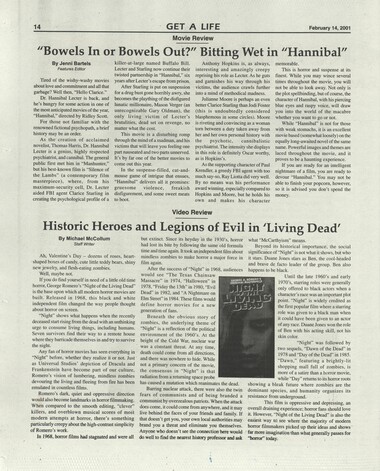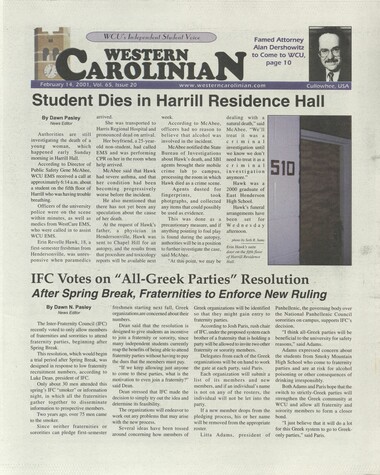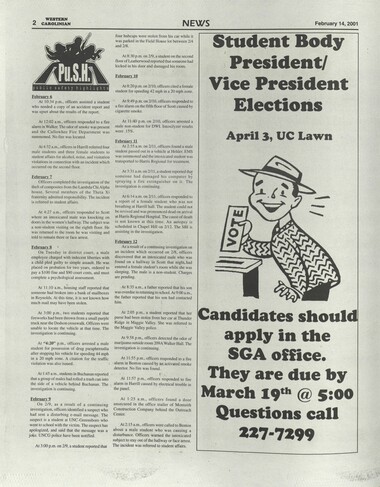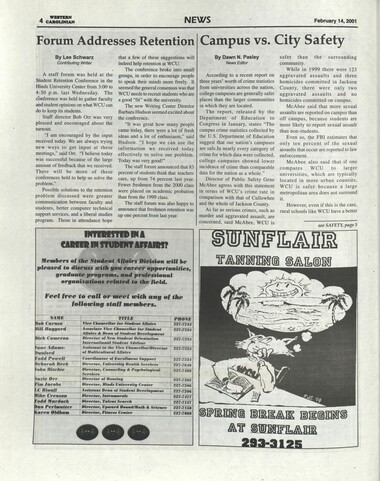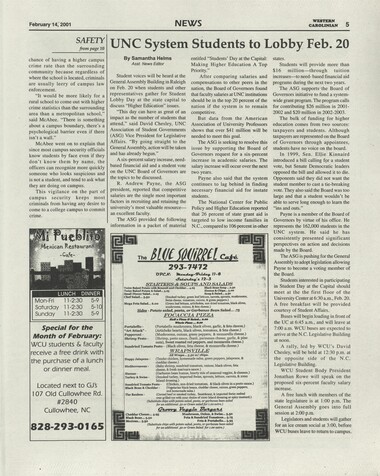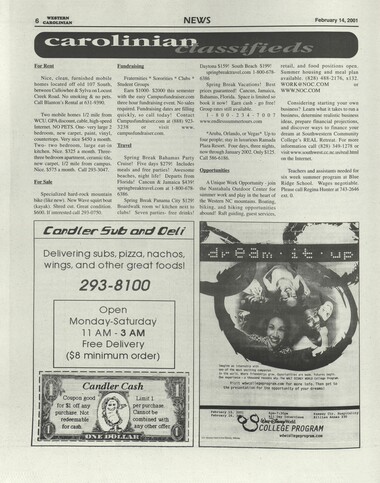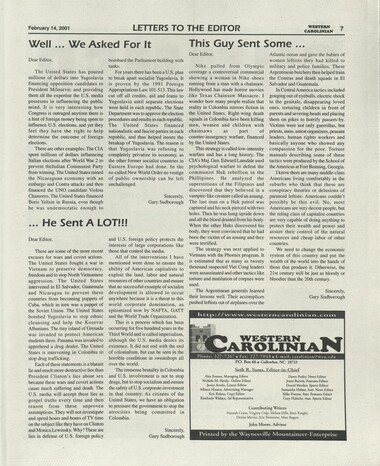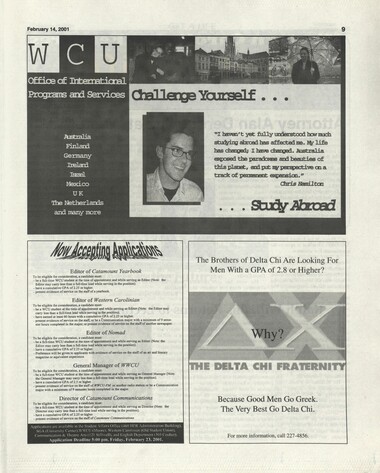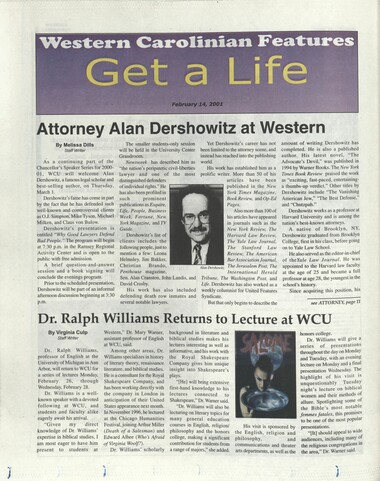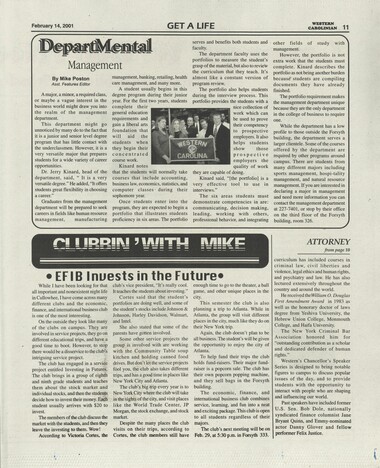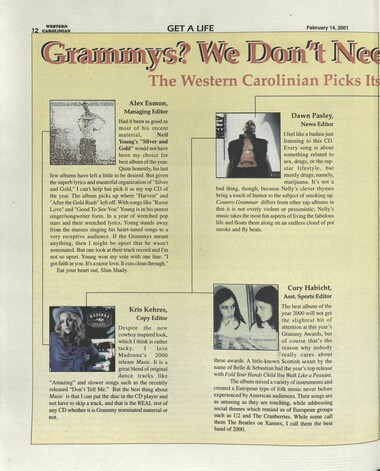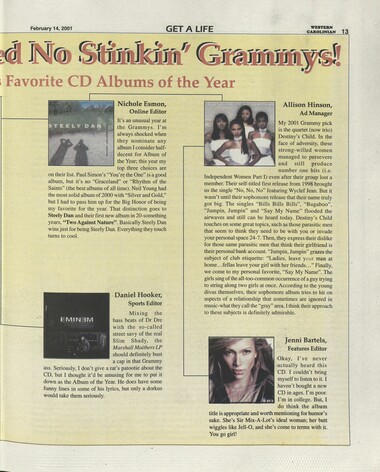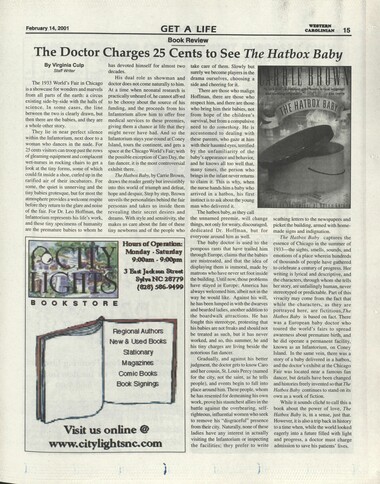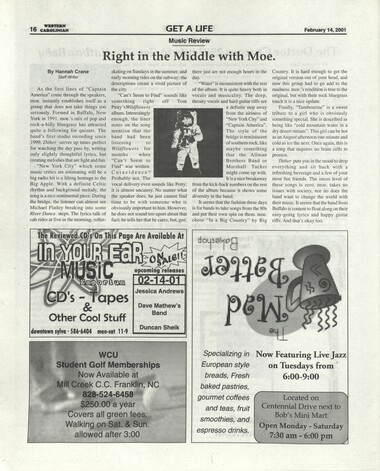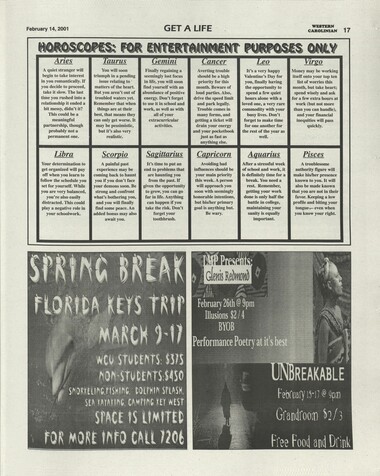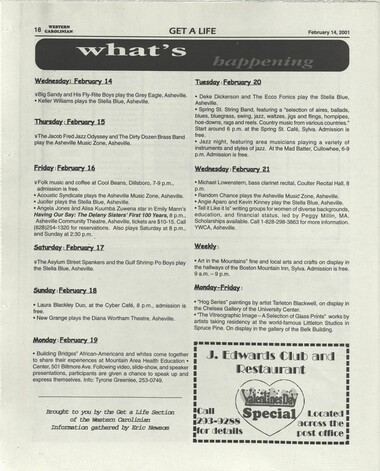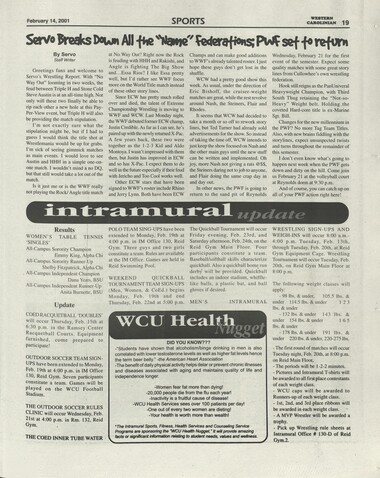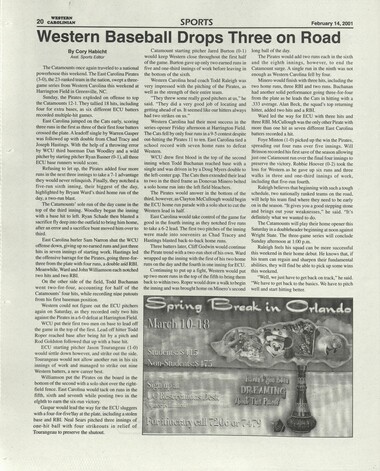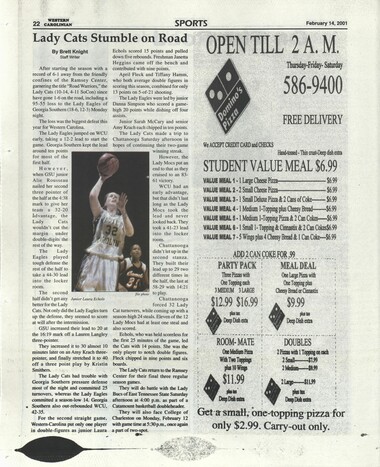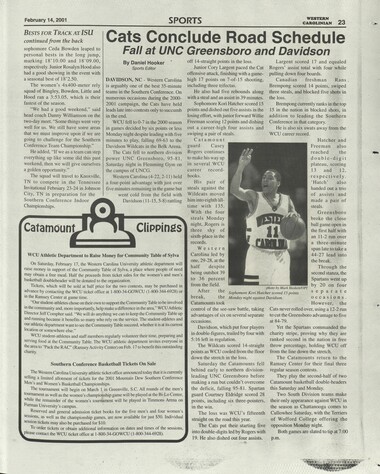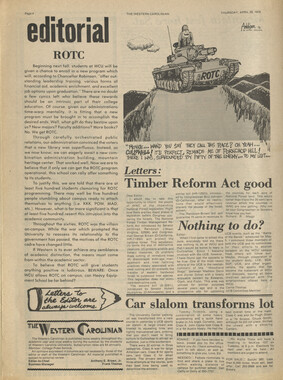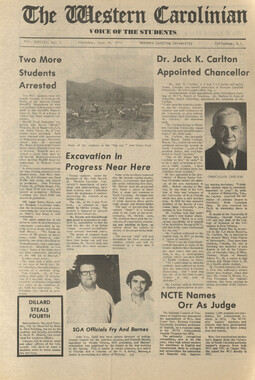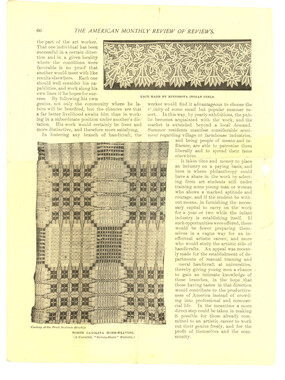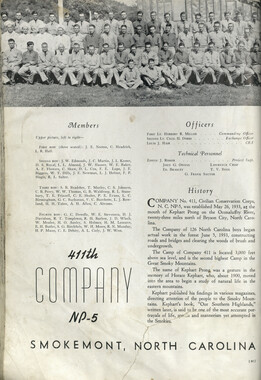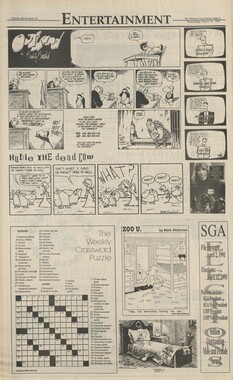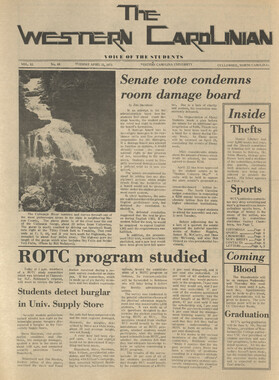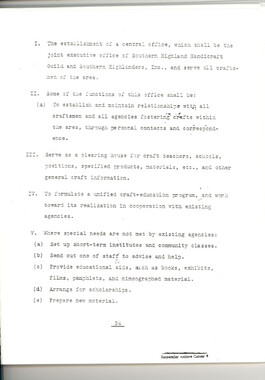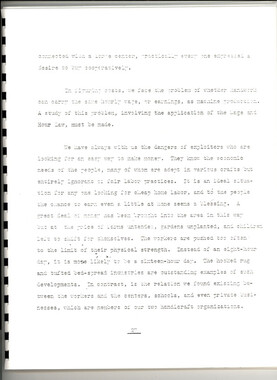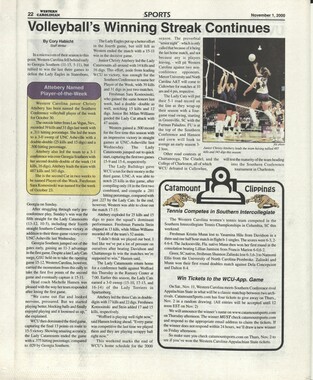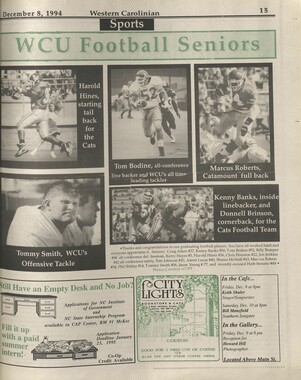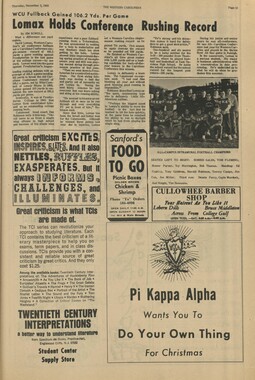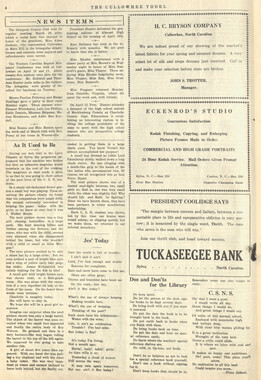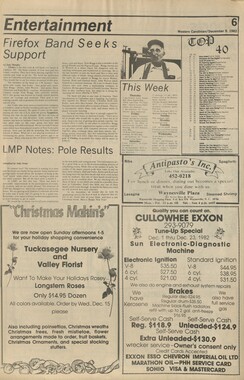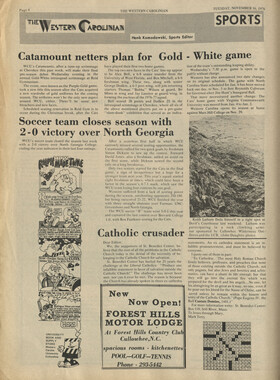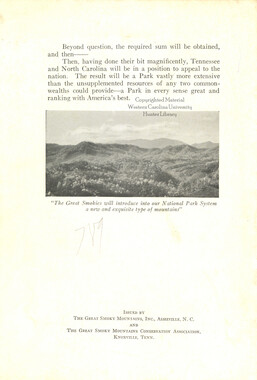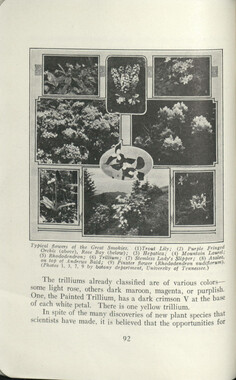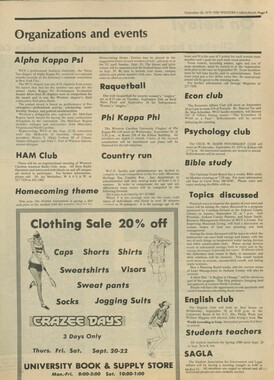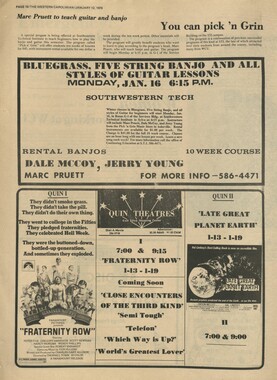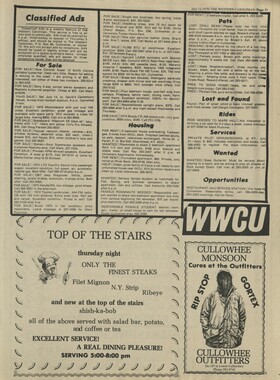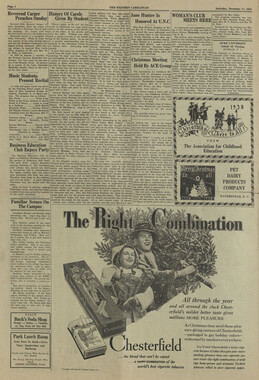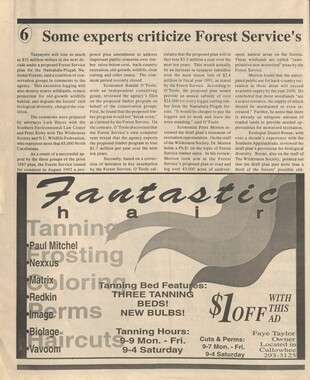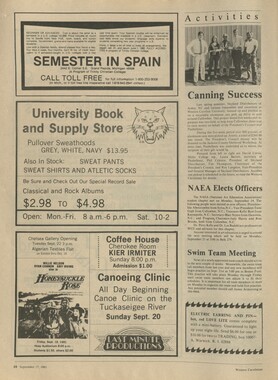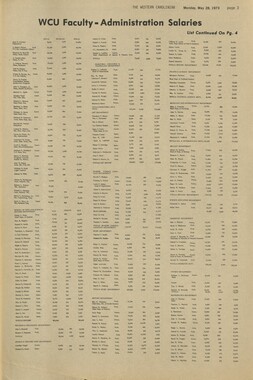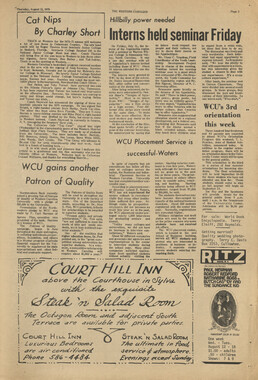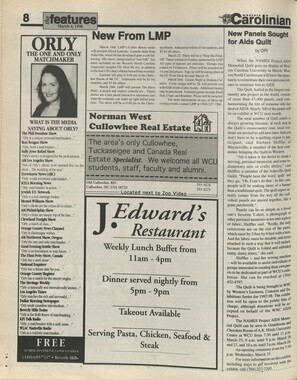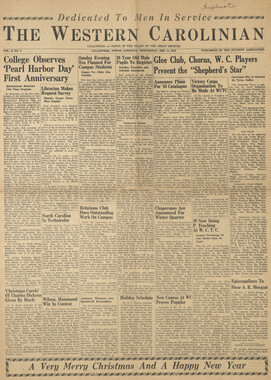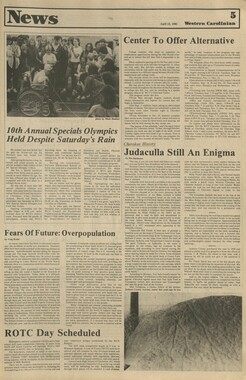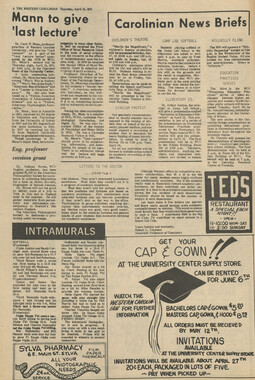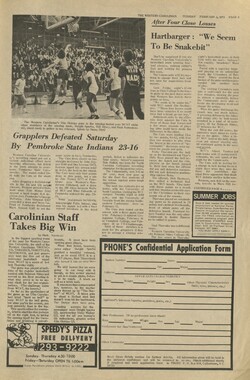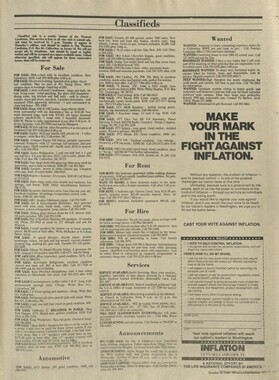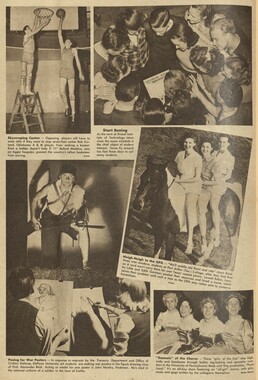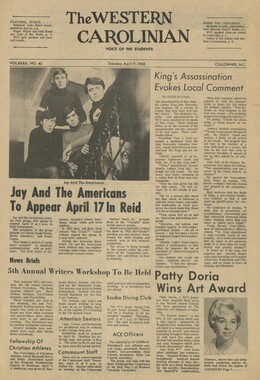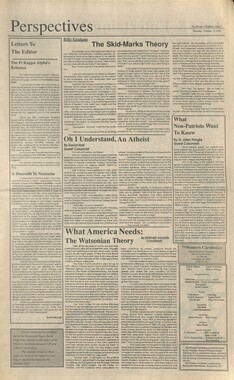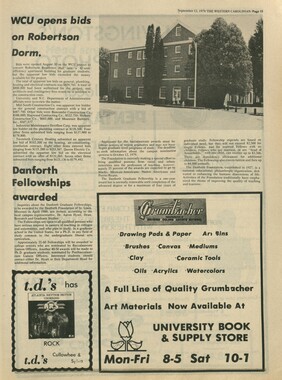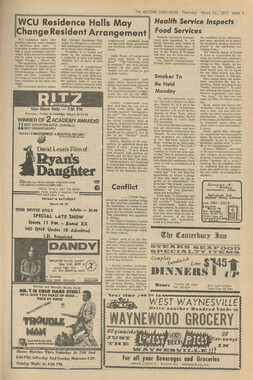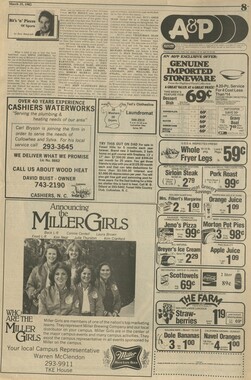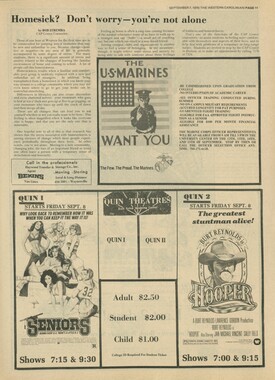Western Carolina University (20)
View all
- Canton Champion Fibre Company (2308)
- Cherokee Traditions (292)
- Civil War in Southern Appalachia (165)
- Craft Revival (1942)
- Great Smoky Mountains - A Park for America (2766)
- Highlights from Western Carolina University (430)
- Horace Kephart (941)
- Journeys Through Jackson (154)
- LGBTQIA+ Archive of Jackson County (85)
- Oral Histories of Western North Carolina (314)
- Picturing Appalachia (6772)
- Stories of Mountain Folk (413)
- Travel Western North Carolina (160)
- Western Carolina University Fine Art Museum Vitreograph Collection (129)
- Western Carolina University Herbarium (92)
- Western Carolina University: Making Memories (708)
- Western Carolina University Publications (2283)
- Western Carolina University Restricted Electronic Theses and Dissertations (146)
- Western North Carolina Regional Maps (71)
- World War II in Southern Appalachia (131)
University of North Carolina Asheville (6)
View all
- Allanstand Cottage Industries (62)
- Appalachian National Park Association (53)
- Bennett, Kelly, 1890-1974 (1388)
- Berry, Walter (76)
- Brasstown Carvers (40)
- Carver, George Washington, 1864?-1943 (26)
- Cathey, Joseph, 1803-1874 (1)
- Champion Fibre Company (233)
- Champion Paper and Fibre Company (297)
- Cherokee Indian Fair Association (16)
- Cherokee Language Program (22)
- Crowe, Amanda (40)
- Edmonston, Thomas Benton, 1842-1907 (7)
- Ensley, A. L. (Abraham Lincoln), 1865-1948 (275)
- Fromer, Irving Rhodes, 1913-1994 (70)
- George Butz (BFS 1907) (46)
- Goodrich, Frances Louisa (120)
- Grant, George Alexander, 1891-1964 (96)
- Heard, Marian Gladys (60)
- Kephart, Calvin, 1883-1969 (15)
- Kephart, Horace, 1862-1931 (313)
- Kephart, Laura, 1862-1954 (39)
- Laney, Gideon Thomas, 1889-1976 (439)
- Masa, George, 1881-1933 (61)
- McElhinney, William Julian, 1896-1953 (44)
- Niggli, Josephina, 1910-1983 (10)
- North Carolina Park Commission (105)
- Osborne, Kezia Stradley (9)
- Owens, Samuel Robert, 1918-1995 (11)
- Penland Weavers and Potters (36)
- Roberts, Vivienne (15)
- Roth, Albert, 1890-1974 (142)
- Schenck, Carl Alwin, 1868-1955 (1)
- Sherrill's Photography Studio (2565)
- Southern Highland Handicraft Guild (127)
- Southern Highlanders, Inc. (71)
- Stalcup, Jesse Bryson (46)
- Stearns, I. K. (213)
- Thompson, James Edward, 1880-1976 (226)
- United States. Indian Arts and Crafts Board (130)
- USFS (683)
- Vance, Zebulon Baird, 1830-1894 (1)
- Weaver, Zebulon, 1872-1948 (58)
- Western Carolina College (230)
- Western Carolina Teachers College (282)
- Western Carolina University (1794)
- Western Carolina University. Mountain Heritage Center (18)
- Whitman, Walt, 1819-1892 (10)
- Wilburn, Hiram Coleman, 1880-1967 (73)
- Williams, Isadora (3)
- Cain, Doreyl Ammons (0)
- Crittenden, Lorraine (0)
- Rhodes, Judy (0)
- Smith, Edward Clark (0)
- Appalachian Region, Southern (2569)
- Asheville (N.C.) (1923)
- Avery County (N.C.) (26)
- Blount County (Tenn.) (161)
- Buncombe County (N.C.) (1672)
- Cherokee County (N.C.) (283)
- Clay County (N.C.) (555)
- Graham County (N.C.) (233)
- Great Smoky Mountains National Park (N.C. and Tenn.) (519)
- Haywood County (N.C.) (3524)
- Henderson County (N.C.) (70)
- Jackson County (N.C.) (4694)
- Knox County (Tenn.) (25)
- Knoxville (Tenn.) (12)
- Lake Santeetlah (N.C.) (10)
- Macon County (N.C.) (420)
- Madison County (N.C.) (212)
- McDowell County (N.C.) (39)
- Mitchell County (N.C.) (132)
- Polk County (N.C.) (35)
- Qualla Boundary (981)
- Rutherford County (N.C.) (76)
- Swain County (N.C.) (2115)
- Transylvania County (N.C.) (270)
- Watauga County (N.C.) (12)
- Waynesville (N.C.) (84)
- Yancey County (N.C.) (72)
- Aerial Photographs (3)
- Aerial Views (60)
- Albums (books) (4)
- Articles (1)
- Artifacts (object Genre) (228)
- Bibliographies (1)
- Biography (general Genre) (2)
- Cards (information Artifacts) (38)
- Clippings (information Artifacts) (191)
- Crafts (art Genres) (622)
- Depictions (visual Works) (21)
- Design Drawings (1)
- Drawings (visual Works) (184)
- Envelopes (73)
- Facsimiles (reproductions) (1)
- Fiction (general Genre) (4)
- Financial Records (12)
- Fliers (printed Matter) (67)
- Glass Plate Negatives (381)
- Guidebooks (2)
- Internegatives (10)
- Interviews (815)
- Land Surveys (102)
- Letters (correspondence) (1013)
- Manuscripts (documents) (618)
- Maps (documents) (177)
- Memorandums (25)
- Minutes (administrative Records) (59)
- Negatives (photographs) (5835)
- Newsletters (1285)
- Newspapers (2)
- Occupation Currency (1)
- Paintings (visual Works) (1)
- Pen And Ink Drawings (1)
- Periodicals (193)
- Personal Narratives (10)
- Photographs (12976)
- Plans (maps) (1)
- Poetry (6)
- Portraits (4533)
- Postcards (329)
- Programs (documents) (151)
- Publications (documents) (2236)
- Questionnaires (65)
- Scrapbooks (282)
- Sheet Music (2)
- Slides (photographs) (402)
- Songs (musical Compositions) (2)
- Sound Recordings (796)
- Specimens (92)
- Speeches (documents) (15)
- Tintypes (photographs) (8)
- Transcripts (322)
- Video Recordings (physical Artifacts) (23)
- Vitreographs (129)
- Text Messages (0)
- A.L. Ensley Collection (275)
- Appalachian Industrial School Records (7)
- Appalachian National Park Association Records (336)
- Axley-Meroney Collection (2)
- Bayard Wootten Photograph Collection (20)
- Bethel Rural Community Organization Collection (7)
- Blumer Collection (5)
- C.W. Slagle Collection (20)
- Canton Area Historical Museum (2110)
- Carlos C. Campbell Collection (282)
- Cataloochee History Project (64)
- Cherokee Studies Collection (4)
- Daisy Dame Photograph Album (5)
- Daniel Boone VI Collection (1)
- Doris Ulmann Photograph Collection (112)
- Elizabeth H. Lasley Collection (1)
- Elizabeth Woolworth Szold Fleharty Collection (4)
- Frank Fry Collection (95)
- George Masa Collection (173)
- Gideon Laney Collection (452)
- Hazel Scarborough Collection (2)
- Hiram C. Wilburn Papers (28)
- Historic Photographs Collection (236)
- Horace Kephart Collection (861)
- Humbard Collection (33)
- Hunter and Weaver Families Collection (1)
- I. D. Blumenthal Collection (4)
- Isadora Williams Collection (4)
- Jesse Bryson Stalcup Collection (47)
- Jim Thompson Collection (224)
- John B. Battle Collection (7)
- John C. Campbell Folk School Records (80)
- John Parris Collection (6)
- Judaculla Rock project (2)
- Kelly Bennett Collection (1407)
- Love Family Papers (11)
- Major Wiley Parris Civil War Letters (3)
- Map Collection (12)
- McFee-Misemer Civil War Letters (34)
- Mountain Heritage Center Collection (4)
- Norburn - Robertson - Thomson Families Collection (44)
- Pauline Hood Collection (7)
- Pre-Guild Collection (2)
- Qualla Arts and Crafts Mutual Collection (12)
- R.A. Romanes Collection (681)
- Rosser H. Taylor Collection (1)
- Samuel Robert Owens Collection (94)
- Sara Madison Collection (144)
- Sherrill Studio Photo Collection (2558)
- Smoky Mountains Hiking Club Collection (616)
- Stories of Mountain Folk - Radio Programs (374)
- The Reporter, Western Carolina University (510)
- Venoy and Elizabeth Reed Collection (16)
- WCU Gender and Sexuality Oral History Project (32)
- WCU Mountain Heritage Center Oral Histories (25)
- WCU Oral History Collection - Mountain People, Mountain Lives (71)
- WCU Students Newspapers Collection (1744)
- Western North Carolina Tomorrow Black Oral History Project (69)
- William Williams Stringfield Collection (2)
- Zebulon Weaver Collection (109)
- African Americans (390)
- Appalachian Trail (35)
- Artisans (521)
- Cherokee art (84)
- Cherokee artists -- North Carolina (10)
- Cherokee language (21)
- Cherokee pottery (101)
- Cherokee women (208)
- Church buildings (170)
- Civilian Conservation Corps (U.S.) (110)
- College student newspapers and periodicals (1830)
- Dams (107)
- Dance (1023)
- Education (222)
- Floods (61)
- Folk music (1015)
- Forced removal, 1813-1903 (2)
- Forest conservation (220)
- Forests and forestry (1184)
- Gender nonconformity (4)
- Great Smoky Mountains National Park (N.C. and Tenn.) (181)
- Hunting (38)
- Landscape photography (25)
- Logging (118)
- Maps (83)
- Mines and mineral resources (8)
- North Carolina -- Maps (18)
- Paper industry (38)
- Postcards (255)
- Pottery (135)
- Railroad trains (71)
- Rural electrification -- North Carolina, Western (3)
- School integration -- Southern States (2)
- Segregation -- North Carolina, Western (5)
- Slavery (5)
- Sports (452)
- Storytelling (244)
- Waterfalls -- Great Smoky Mountains (N.C. and Tenn.) (66)
- Weaving -- Appalachian Region, Southern (280)
- Wood-carving -- Appalachian Region, Southern (328)
- World War, 1939-1945 (173)
Western Carolinian Volume 65 (66) Number 20
Item
Item’s are ‘child’ level descriptions to ‘parent’ objects, (e.g. one page of a whole book).
-
-
14 GET A LIFE February 14, 2001 Movie Review "Bowels In or Bowels Out?" Bitting Wet in "Hannibal tr By Jenni Bartels Features Editor Tired of the wishy-washy movies about love and commitment and all that garbage? Well then, "Hello Clarice." Dr. Hannibal Lecter is back, and he's hungry for some action in one of the most anticipated movies of the year, "Hannibal," directed by Ridley Scott. For those not familiar with the renowned fictional psychopath, a brief history may be an order. As the creation of acclaimed novelist, Thomas Harris, Dr. Hannibal Lecter is a genius, highly respected psychiatrist, and cannibal. The general public first met him in "Manhunter," but his best-known film is "Silence of the Lambs" (a contemporary film masterpiece), where, from his maximum-security cell, Dr. Lecter aided FBI agent Clarice Starling in creating the psychological profile of a killer-at-large named Buffalo Bill. Lecter and Starling now continue their twisted partnership in "Hannibal," six years after Lecter's escape from prison. After Starling is put on suspension for a drug bust gone horribly awry, she becomes the plaything of the disfigured lunatic millionaire, Mason Verger (an unrecognizable Gary Oldman), the only living victim of Lecter's brutalities, dead set on revenge, no matter what the cost. This movie is a disturbing romp through the mind of a madman, and his victims that will leave you feeling one part nauseated and two parts unnerved. It's by far one of the better movies to come out this year. In the suspense-filled, cat-and- mouse game of intrigue that ensues, "Hannibal" delivers all it promises: gruesome violence, freakish disfigurement, and some sweet meats to boot. Anthony Hopkins is, as always, interesting and amazingly creepy reprising his role as Lecter. As he guts and garnishes his way through his victims, the audience crawls further into a mind of methodical madness. Julianne Moore is perhaps an even better Clarice Starling than Jodi Foster (this is undoubtedly considered blasphemous in some circles). Moore is riveting and convincing as a woman torn between a duty taken away from her and her own personal history with the psychotic, cannibalistic psychiatrist. The intensity she displays in this role is definitely Oscar worthy, as is Hopkins's. As the supporting character of Paul Krendler, a greedy FBI agent with too much say-so, Ray Liotta did very well. By no means was his performance award winning, especially compared to Hopkins and Moore, but he holds his own and makes his character memorable. This is horror and suspense at its finest. While you may wince several times throughout the movie, you will not be able to look away. Not only is the plot spellbinding, but of course, the character of Hannibal, with his piercing blue eyes and raspy voice, will draw you into the world of the macabre whether you want to go or not. While "Hannibal" is not for those with weak stomachs, it is an excellent movie based (somewhat loosely) on the equally long-awaited novel of the same name. Powerful images and themes are laced throughout the movie, and it proves to be a haunting experience. If you are ready for an intelligent nightmare of a film, you are ready to devour "Hannibal." You may not be able to finish your popcorn, however, so it is advised you don't spend the money. Video Review Historic Heroes and Legions of Evil in 'Living Dead' By Michael McCollum Staff Writer Ah, Valentine's Day - dozens of roses, heart- shaped boxes of candy, cute little teddy bears, shiny new jewelry, and flesh-eating zombies. Well, maybe not. If you do find yourself in need of a little old time horror, George Romero's "Night of the Living Dead" is the base upon which all modern horror movies are built. Released in 1968, this black and white independent film changed the way people thought about horror on screen. "Night" shows what happens when the recently deceased start rising from the dead with an unthinking urge to consume living things, including humans. Seven survivors find their way to a remote house where they barricade themselves in and try to survive the night. Any fan of horror movies has seen everything in "Night" before, whether they realize it or not. Just as Universal Studios' depiction of Dracula and Frankenstein have become part of our culture, Romero's vision of lumbering, mindless zombies devouring the living and fleeing from fire has been emulated in countless films. Romero's dark, quiet and oppressive direction would also become landmarks in horror filmmaking. When compared to the smooth editing, "clever" killers, and overblown musical scores of most modern attempts at horror, there's something particularly creepy about the high-contrast simplicity of Romero's work. In 1968, horror films had stagnated and were all but extinct. Since its heyday in the 1930's, horror had lost its bite by following the same old formula time and time again. It took an independent film about mindless zombies to make horror a major force in film again. After the success of "Night" in 1968, audiences would see "The Texas Chainsaw Massacre" in 1974, "Halloween" in 1978, "Friday the 13th" in 1980, "Evil Dead" in 1982, and "A Nightmare on Elm Street" in 1984. These films would define horror movies for a new generation of fans. Beneath the obvious story of zombies, the underlying theme of "Night" is a reflection of the political environment of the 1960's. At the height of the Cold War, nuclear war was a constant threat. At any time, death could come from all directions, and there was nowhere to hide. While not a primary concern of the movie, the consensus in "Night" is that radiation from a returning space probe has caused a mutation which reanimates the dead. Barring nuclear attack, there were also the twin fears of communists and of being branded a communist by overzealous patriots. When the attack does come, it could come from anywhere, and it may live behind the faces of your friends and family. If that doesn't get you, your own local authorities may brand you a threat and eliminate you themselves. Anyone who doesn't see the connection here would do well to find the nearest history professor and ask what "McCarthyism" means. Beyond its historical importance, the social significance of "Night" is not what it shows, but who it stars. Duane Jones stars as Ben, the cool-headed and brave de facto leader of the group. Ben also happens to be black. Until the late 1960's and early 1970's, starring roles were generally only offered to black actors when a character's race was an important plot point. "Night" is widely credited as the first popular film where a starring role was given to a black man when it could have been given to an actor of any race. Duane Jones won the role of Ben with his acting skill, not his skin color. "Night" was followed by two sequels, "Dawn of the Dead" in 1978 and "Day of the Dead" in 1985. "Dawn," featuring a brightly-lit shopping mall full of zombies, is more of a satire than a horror movie, while "Day" returns to its horror roots showing a bleak future where zombies are the dominant species, and humanity organizes its resistance from underground. This film is oppressive and depressing, an overall draining experience; horror fans should love it. However, "Night of the Living Dead" is also the easiest way to see where the majority of modern horror filmmakers picked up their ideas and shows far more imagination than what generally passes for "horror" today.
Object
Object’s are ‘parent’ level descriptions to ‘children’ items, (e.g. a book with pages).
-
The Western Carolinian is Western Carolina University's student-run newspaper. The paper was published as the Cullowhee Yodel from 1924 to 1931 before changing its name to The Western Carolinian in 1933.
-
